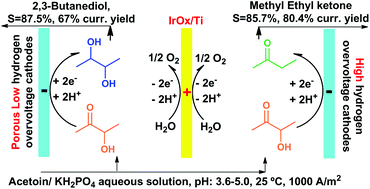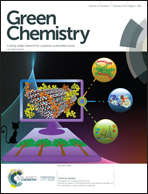Abstract
Acetoin could shortly become a platform molecule due to current progress in fermentation technology, the megatrend for shifting from an oil-based economy to the one based on biomass, the quest for green manufacturing processes and its two highly reactive carbonyl and hydroxyl moieties. In this paper, the successful electro-conversion of acetoin into two valuable chemicals, 2,3-butanediol (2,3-BD) and methyl ethyl ketone (MEK), at a constant electrical current in an aqueous phase at room temperature using both divided and undivided 20 cm2 filter-press flow cells under experimental conditions suitable for industrial production is reported. Cathode material is the key parameter to drive the electroreduction towards one or another chemical. 2,3-BD is the major chemical produced by electrohydrogenation when low hydrogen overvoltage cathodes, such as Pt and Ni, of high surface areas obtained by PVD coating on a carbon gas diffusion layer are used, while MEK is the principal product produced by electrohydrogenolysis when high hydrogen overvoltage cathodes, such as graphite, Pb and Cd foils, are employed. 2,3-BD and MEK can be obtained, respectively, in 92.8% and 85.7% selectivities, 71.7% and 80.4% current efficiencies, with 1.21 and 1.08 kg h−1 m−2 productivities and power consumptions of 2.94 and 4.1 kWh kg−1 using undivided cells and aqueous K2HPO4 electrolysis media at pH values of 3.6 and 5.5. The reported electroconversion of acetoin is highly flexible because 2,3-BD and MEK can be produced by changing just the cathode but using the same cell, with the same electrolyte at the same current density.



 Please wait while we load your content...
Please wait while we load your content...